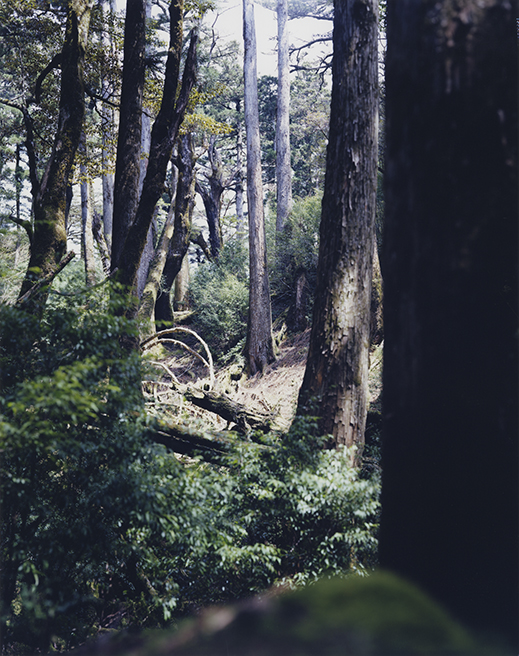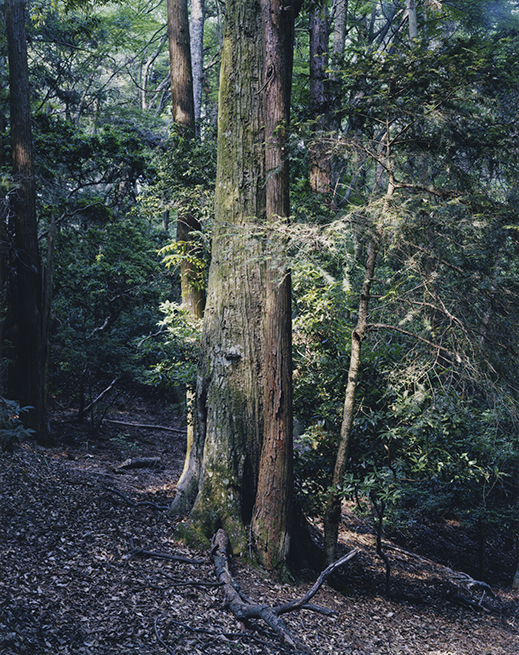 |
 |
 |
HOME > FOCUS > Forest Contemplations by Yoshihiko Ueda, and the Closing of an Iconic Gallery |
 |
 |
Focus features two in-depth reviews each month of fine art, architecture and design exhibitions and events at art museums, galleries and alternative spaces around Japan. The contributors are non-Japanese residents of Japan. |
|
|
 |
 |
 |
Forest Contemplations by Yoshihiko Ueda, and the Closing of an Iconic Gallery
Susan Rogers Chikuba |
 |
A first impression upon entering Gallery 916 from the galvanized city outside is that the works on display are windows onto a suddenly, strangely, forested world. How could it be that green living things are there, just beyond these walls? As you move through the space the illusion expands: the gallery itself becomes the forest and you, a wanderer in it. Installation view © Yoshihiko Ueda |
On the elevated track to my left, a driverless Yurikamome train moved soundlessly out of Takeshiba Station on its rubber wheels. The ground shook: a truck hauling a few tons of I-beams trundled past, its destination the massive construction site I saw in front of me, reflected in the wire-mesh glass of a warehouse door. An unassuming poster stuck in a worn metal stand assured me I had the place right -- there was the fern-covered floor of the Quinault Rain Forest, a photo taken by Yoshihiko Ueda last year. Train, truck, trees -- and a brain sifting this three-second riot of information. An instant slightly longer than the sun-dappled measure of time caught on film there in the exhibition announcement, and yet only the latter felt ageless.
The blurred foreground of some images beckons the searching mind deeper into the forest. Does a sharper focus lie within? Quinault 2017 © Yoshihiko Ueda |
Ueda opened Gallery 916, a 600-square-meter oasis for fine-art photography, on the top floor of No. 3 Suzue Building in 2012. Now, 25 exhibitions later, the converted warehouse is slated for demolition. The present show is the last opportunity to enjoy this much-loved space. With its varnished concrete floors, industrial fittings, and boxy ironbound windows, you'd think the structure was from the 1960s. Ueda's eclectic pieces of retro furniture heighten that impression, but in fact the building was only erected in 1991 (such is the fast-and-furious cycle of Tokyo real estate). With tenants on other floors engaged in film production, art publishing, floral design, and even Burmese lethwei boxing, you never know who or what you'll be sharing the freight elevator with, and that, too, has been part of this venue's endearing charm.
 |
|
"In the forest," writes Ueda, "I can bear witness to the soothing rhythm of life at any moment -- an experience akin to suddenly encountering a passage of music with an exquisite melody." Materia 2011 © Yoshihiko Ueda |
Forest: Impressions and Memories, 1989-2017 is a collection of 49 prints from Ueda's Quinault (1991), Materia (2012) and M. River (2013) series, as well as new works. The photographs are of three places: Quinault, the temperate rain forest in northwest Washington state, known for its giant cedars, spruces and hemlocks; the subtropical evergreen forest of Yakushima, an island south of Kyushu renowned for its cedars; and the sacred forest surrounding Kasuga Taisha shrine in Nara, untouched for a millennium.
Of the many forests he's explored, Ueda says, what unites this particular trio for him is an ineffable conviction -- demonstrated by others before us across the ages -- that they must be preserved. Quinault is both a sacred land of the Quinault Indian Nation and a national park. Yakushima and Kasuga are UNESCO World Heritage sites; Kasuga has remained largely unspoiled since logging and hunting were banned in 841. Ueda's quest, and his invitation to us, is to consider why this is so. What power do these places hold that compels us to protect them? What is it in us that perceives that power, and from where does it stem?
 |
|
"Gaze and consciousness shift and awaken, shift and awaken, these movements continuing indefinitely I suppose, if I can just keep my eyes on the scene." Kasuga 2017 © Yoshihiko Ueda |
There are no soaring shots of sky or canopy here. Our attention is drawn instead to what's right in front of us, or perhaps lying at our feet. As you walk through the gallery, you'll notice that a fair number of works are hung low -- far enough below eye level that in order to engage with them you must squat, just as you might on a trail in the woods to inspect a plant. In this way, as well, Ueda draws us down to the root of our experience. Indeed, to Mother Earth.
And yet his compositions employ none of landscape photography's conventional means of directing our attention. There are no S curves, no vanishing points or diagonal lines, and not even much framing. It's as though we are invited to be as we might in the woods ourselves: mindful of our surroundings, scanning the scenery as it comes, open to subtle messages -- a stance more important, biologically and spiritually, than knowing just where to look. Ultimately, what you seek and what you find will be a personal quest.
 |
|
"Wandering through a forest," art historian Toshiharu Ito wrote of a show Ueda held last year, "you become aware that many different things are flowing forth and mixing. Our bodies and souls, too, flow forth and mix with the forest." Quinault 1990 © Yoshihiko Ueda |
The guestbook is filled with statements about what Gallery 916 has meant to people over the years, and not just Tokyoites. More than a few out-of-towners write of it being a must-stop on their every trip to the city. And clearly, Ueda's forest images stir things keenly felt -- the impressions shared by visitors testify to his success at conveying some essence, at triggering a search toward wider meaning. "I had always thought of the forest as something deep, dark, and gloomy," one person offers. "For me it's a scary place, something I'd rather avoid. In your photos I saw the weight of it, but also its patches of light where both creeping groundcover and mighty trees grow. It was good to stay there for awhile."
"At first the photographs seemed to me like paintings. But then I noticed they were alive," pens another. Still others wrote, "I could hear the cicadas." ... "The scent of the forest is here." ... "I felt the presence of souls, there in the woods." ... "Lichens, ferns, mosses -- how important that we take the time to really see them, wholly."
 |
|
"Your forests drew me in," a gallerygoer writes. "They said, 'Live.'" Materia 2011 © Yoshihiko Ueda |
To shoot all of the exhibited works, Ueda used an 8x10 large-format camera -- equipment that lends itself to the slow pace of the forest and the contemplative theme. But just imagine what it took to carry all of that bulk and weight into and out of such wild terrain, at high elevations.
In time No. 3 Suzue Building will be replaced with one more gleaming tower of steel and glass. Redevelopment of the Takeshiba area -- close by Tokyo Bay and Haneda Airport, and so yet another much-heralded business hub -- is scheduled for completion in 2020, like many large-scale projects fueled by Olympic mania. The developer's motto is "building smiles," but no one is happy about the impending loss of one of Tokyo's most beloved galleries. Though the trains will come and go and the trucks will still rumble by on the expressway next door, there'll be no duplicating this place, and its organic mix of tenants.
Life in the forest, it can be hoped, will continue on for many more millennia.
 |
|
"I caress the gradation of silver-blue on bark and pale yellow-green of the moss softly with my eyes," Ueda writes in his artist's statement. "Without my noticing, my attention has been diverted entirely to color." Kasuga 2017 © Yoshihiko Ueda |
A number of events, conducted in Japanese, are planned before the exhibition closes. On 3 March, photography historian Kotaro Iizawa will join Ueda for a talk from 4 p.m., followed at 6:30 by "Moon in the Forest," a solo concert by bassist Seigo Matsunaga. On 10 March, associate curator Naoko Ohta will lead a gallery tour addressing visual literacy and art appreciation from 3 p.m. Aspiring photographers take note -- she'll conduct an open review of portfolios afterwards. Finally, on 24 March, the show's last evening, Ueda will be joined by Ohta and art director Hideaki Nakajima for a talk from 3 p.m. No reservations for these dates are required, although you may want to arrive early.
"I roamed through the air, wind, sounds, scents, and colors of the forest. I will miss this place," a gallerygoer writes. Photo by Susan Rogers Chikuba |
All photos by the artist are reproduced with the permission of Gallery 916.
|
 |
 |
Susan Rogers Chikuba
Susan Rogers Chikuba, a Tokyo-based writer, editor and translator, has been following popular culture, architecture and design in Japan for three decades. She covers the country's travel, art, literary and culinary scenes for domestic and international publications. |
|
 |
|
|
 |
|
 |
|